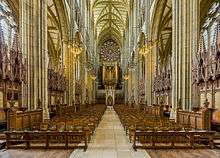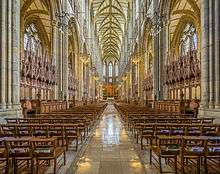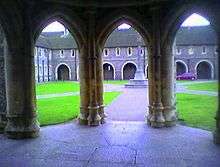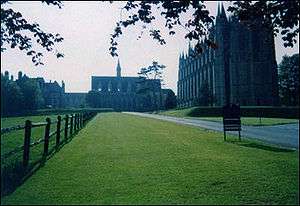Lancing College
Lancing College is an independent boarding and day school in southern England, UK. The school is located in West Sussex, east of Worthing near the village of Lancing, on the south coast of England. Lancing was founded in 1848 by Nathaniel Woodard and educates c. 600 pupils between the ages of 13 and 18; the co-educational ratio is c. 60:40 boys to girls. Girls were admitted beginning in 1971.
| Lancing College (formerly College of St Mary and St Nicolas) | |
|---|---|
 | |
| Location | |
| , , BN15 0RW England | |
| Information | |
| Type | Public school Independent day and boarding |
| Motto | 'Beati Mundo Corde'[1] (Blessed are the pure in heart)[2] |
| Religious affiliation(s) | Church of England |
| Established | 1848 |
| Founder | Nathaniel Woodard |
| Department for Education URN | 126108 Tables |
| Chairman | Martin Slumbers |
| Head Master | Dominic Oliver, MPhil |
| Gender | Mixed |
| Age | 13 to 18 |
| Enrolment | c.600 |
| Houses | 10 |
| Colour(s) | Blue and White and Gold |
| Publication | The Quad |
| Former pupils | OLs |
| Affiliation | Woodard Corporation |
| Website | http://www.lancingcollege.co.uk/ |
The college is situated on a hill which is part of the South Downs, and the campus dominates the local landscape. The college overlooks the River Adur, and the Ladywell Stream, a holy well or sacred stream within the College grounds, has pre-Christian significance.[3] Woodard's aim was to provide education "based on sound principle and sound knowledge, firmly grounded in the Christian faith." Lancing was the first of a family of more than 30 schools founded by Woodard (others include Hurstpierpoint College, Ardingly College, Bloxham School and Worksop College).
Roughly 65% of pupils are boarders, at a cost of £37,065 per year; c. 35% are day pupils, at a cost of £25,320 per year. Occasional overnight stays are available to day pupils at an additional cost.[4]
The school is a member of the Headmasters' and Headmistresses' Conference. Girls were first admitted in 1970. The school is dominated by a Gothic revival chapel, and follows a high church Anglican tradition. The College of St Mary and St Nicolas (as it was originally known) in Shoreham-by-Sea was intended for the sons of upper middle classes and professional men; in time this became Lancing College, moving to its present site in 1857.
The school's buildings of the 1850s were designed by the architect Richard Cromwell Carpenter, with later ones by John William Simpson.
In 2003, it was one of fifty of the country's leading independent schools which were found guilty of running an illegal price-fixing cartel which had allowed them to drive up fees for thousands of parents.[5] Each school was required to pay a nominal penalty of £10,000 and all agreed to make ex-gratia payments totalling three million pounds into a trust designed to benefit pupils who attended the schools during the period in respect of which fee information was shared.
Chapel




The foundation stone of the college chapel was laid in 1868, but the chapel itself was not finished in Woodard's lifetime. In fact, the chapel remains unfinished. It stands at about 50 metres (with foundations going down 20 metres into the ground), but the original plans called for a tower at the west end which would raise the height to 100 metres. The apex of the vaulting rises to 27.4 m (90 ft).[6] It was designed by R. H. Carpenter and William Slater, and is built of Sussex sandstone from Scaynes Hill.
The chapel was dedicated to St Mary and St Nicolas in 1911, although the college worshipped in the finished crypt from 1875. Inside can be found, among other things, the tomb of the founder, three organs, and a rose window designed by Stephen Dykes Bower, completed in 1977, and the largest rose window in England, being 32 ft in diameter. People acknowledge it as the largest school chapel in the world, despite the fact that there appears to be no study or survey publicly available that can confirm that.
The eastern organ is a two-manual mechanical organ built by the Danish firm Frobenius and was installed and voiced in situ in 1986. That year also marked the completion of the rebuild of the four-manual Walker organ at the west end of the chapel[7] – both of which were showcased in the opening concert by the American organ virtuoso, Carlo Curley.
A stained-glass window was commissioned in memory of Trevor Huddleston OL, and consecrated by Desmond Tutu on 22 May 2007.
The chapel is closed to the public.
Campus
During World War II, students were evacuated to Downton Castle in Herefordshire.[8] Both the main college and the prep school buildings were requisitioned by the Admiralty and became part of the Royal Navy shore establishment HMS King Alfred.
Developments

In 1856 Lancing created its own code of football which (unlike other school codes) was regarded as a means of fostering teamwork.[9]
Notable alumni

Arts
- George Warner Allen (1916–1988), artist
- Tim Battersby,(1962–1967) composer, musician and lyricist
- David Bedford (1937–2011), composer
- Giles Cooper (1918–1966), radio dramatist
- John Lowry-Corry, 8th Earl Belmore, art collector
- Frederick Gore (1913–2009), artist, educator and author
- Brodrick Haldane (1912–1996), society portrait photographer
- Henry Hardy, editor and composer
- Sir Peter Pears (1910–1986), tenor
- Edward Piper (1938–1990), artist (son of John Piper)
- Sir Tim Rice, lyricist
- Neil Richardson (1930–2010), composer
Literature
- Stuart Cloete (1897–1976), novelist
- Andrew Crofts (author), ghostwriter
- Plantagenet Somerset Fry (1931–1996), historian and author
- Mark Mills (writer), novelist and screenplay writer
- Jan Morris, author and journalist
- Alex Preston, novelist
- Tom Sharpe, novelist
- Evelyn Waugh (1903–1966), novelist
- Philip Womack, author and journalist
Broadcasting, theatre and film
- George Baker (1931–2011), actor
- Christopher Hampton, playwright
- Sir David Hare, playwright
- Alex Horne, comedian
- Royce Ryton (1924–2009), actor and playwright
- Jeremy Sinden (1950–1996), actor
- Dali Tambo, South African TV presenter
- Jamie Theakston, TV and radio presenter
- John Williams (actor) (1903–1983), actor
- Simon Rockell, Producer
Politics and law
- Nana Addo Dankwa Akufo-Addo, President of Ghana (2017–)
- Greg Barker, Baron Barker of Battle, Minister of State for Energy and Climate Change (2010–2014)
- Nicholas Browne-Wilkinson, Baron Browne-Wilkinson, Vice-Chancellor of the Supreme Court (1985–1991), Senior Lord of Appeal in Ordinary (1995–2000)
- Tom Driberg, Baron Bradwell (1905–1976), Chairman of the Labour Party (1957–1958)
- Sir Roger Fulford (1902–1983), President of the Liberal Party (1964–1965)
- Patrick Maitland, 17th Earl of Lauderdale (1911–2008), Member of Parliament for Lanark (1951–1959)
- Sir Robert Megarry (1910–2006), Vice-Chancellor of the Chancery Division (1976–1981), Vice-Chancellor of the Supreme Court (1982–1985)
- Hugh Molson, Baron Molson (1903–1991), Minister of Works (1957–1959)
- William Rhys Powell, barrister, Member of Parliament for Corby (1983–1997)
- Sir Charles Arthur Roe (1841–1926), Chief Justice of the Lahore High Court (1895–1898)
- John Sankey, 1st Viscount Sankey (1866–1948), Lord High Chancellor of Great Britain (1929–1935)
- William Thomas Wells (1908–1990), barrister, Member of Parliament for Walsall (1945–1955) and Walsall North (1955–1974)
- Rob Wilson, Minister for Civil Society (Cabinet Office) (2014–2017)
Diplomatic service
- Sir Philip Adams (1915–2001), British Chargé d'affaires to Sudan (1954–1956), British Ambassador to Jordan (1966–1970), British Ambassador to Egypt (1973–1975)
- David Lloyd (diplomat), British Ambassador to Slovenia (1997–2000)
- Sir Christopher Meyer, British Ambassador to Germany (1997), British Ambassador to the United States (1997–2003)
- Andrew Page, British Ambassador to Slovenia (2009–2013)
- Sir Elwin Palmer (1852–1906), diplomat and colonial administrator
- Sir John Richmond (diplomat) (1909–1990), British Ambassador to Kuwait (1961–1963), British Ambassador to Sudan (1965–1966)
- Humphrey Trevelyan, Baron Trevelyan (1905–1985), British Chargé d'affaires to China (1953–1955), British Ambassador to Egypt (1955–1956), British Ambassador to Iraq (1958–1961), British Ambassador to Russia (1962–1965), last High Commissioner of Aden (1967)
- Edward Twining, Baron Twining (1899–1967), Governor and Commander-in-Chief, North Borneo (1946–1949); Governor and Commander-in-Chief, Tanganyika (1949–1958)
- Sir Armigel Wade (1890–1966), Colonial Secretary in Kenya (1934–1939)
Sciences
- Sir Roy Calne, pioneer of liver transplantation
- Jack Herbert Driberg, anthropologist[10]
- Basil William Sholto Mackenzie, 2nd Baron Amulree (1900–1983), physician and geriatrician
- Charles Francis Massey Swynnerton (1877–1938), naturalist
- Gino Watkins (1907–1932), Arctic explorer
The Church
- Michael Ball, suffragan Bishop of Jarrow (1980–1990) and Bishop of Truro (1990–1997)
- Peter Ball, suffragan Bishop of Lewes (1977–1992) and Bishop of Gloucester (1992–1993), convicted sex offender
- Christopher Russell Campling, Dean of Ripon (1984–1995)
- Thomas William Cook (1866–1928), Bishop of Lewes (1926–1928)
- Charles John Corfe (1843–1921), inaugural Bishop in Korea (1889–1904)
- Anthony Charles Foottit, Bishop of Lynn (1999–2003)
- Sir Francis Heathcote, 9th Baronet (1868–1961), Anglican Bishop of New Westminster (1940–1951)
- Sir Edwyn Hoskyns, 12th Baronet (1851–1925), Bishop of Burnley (1901–1904), Bishop of Southwell (1904–1925)
- Trevor Huddleston (1913–1998), Archbishop of the Indian Ocean (1976–1984), Bishop of Masasi (1959–1968), Bishop of Stepney (1968–1978), Bishop of Mauritius (1978–1984)
- John Dudley Galtrey Kirkham, Bishop of Sherborne (1976–2001)
- Lewis Evan Meredith (1900–1968), Bishop of Dover (1957–1964)
- Cyril Jonathan Meyrick, Bishop of Lynn (2011–)
- David Reindorp, vicar of Chelsea Old Church, Chaplain to the Honourable Artillery Company and to the Worshipful Company of Fan Makers
- Erik Routley (1917–1982), Congregational minister, composer and musicologist
- James Leo Schuster (1912–2006), Bishop of St John's (1956–1980)
- Henry Edward Champneys Stapleton, Dean of Carlisle (1988–1998)
- Mark Napier Trollope (1862–1930), third Bishop in Korea (1911–1930)
Armed forces
- Lt-Gen Sir Louis Jean Bols (1867–1930), Chief of Staff to the Third Army (World War I), Chief Administrator of Palestine (1919–1920)
- Major-General Eric Louis Bols (1904–1985), General Officer Commanding (GOC) 6th Airborne Division (1944–1946)
- Brig Sir Iltyd Nicholl Clayton (1886–1965), policy-maker active in formation of the Arab League
- Col. Andrew Croft (1906—1998), explorer and member of the Special Operations Executive
- Lt-Gen Sir John Fullerton Evetts (1891–1988), Assistant Chief of the Imperial General Staff (1942–1944), Master-General of the Ordnance (1944–1946)
- H.S.H. Maj Prince George G. Imeretinsky (1897–1972), Grenadier Guards and Royal Flying Corps Officer
- H.S.H. Sqn Ldr Prince Michael Imeretinsky (1900–1975), Royal Flying Corps and Royal Air Force Volunteer Reserve Officer
- Col St George Corbet Gore (1849–1913), Surveyor General of India (1899–1904)
- Thomas Percy Henry Touchet-Jesson, 23rd Baron Audley (1913–1963), soldier, playwright
- Capt John Letts (1897–1918), First World War flying ace
- Maj George Henry Wellington Loftus, 7th Marquess of Ely (1903–1969), soldier
- Maj Galbraith Lowry-Corry, 7th Earl Belmore (1913–1960), soldier
- Lt-Gen Vyvyan Pope (1891–1941), GOC XXX Corps (1941)
- AVM John Frederick Powell (1915–2008), Director of Education Services RAF
- Sqn Ldr/Lt Cdr Jeffrey Quill (1913–1996), Spitfire test pilot
- Lt-Gen Sir Alan Reay (1925–2012), Director General Army Medical Services (1981–1984)
- Gen Sir Neil Ritchie (1897–1983), Commander-in Chief, Eighth Army (1941–1942)
- Maj-Gen David Rutherford-Jones, Commandant of the Royal Military Academy, Sandhurst (2007–2009), Military Secretary (2009–2011)
- AVM Sir Stanley Vincent (1897–1976), Air Officer Commanding No. 13 Group (1943–1944), Air Officer Commanding No. 11 Group (1948–1950), only RAF pilot to shoot down the enemy in both world wars
- Maj-Gen Sir Alexander Wilson (1858–1937), Lieutenant Governor of Jersey (1916–1920)
- RAdm Sir Robert Woodard, Commander of the Royal Yacht Britannia (1985–1990)
Business
- Sir Edgar Beck (1911–2000), Chairman (1961–79) then President (1981–2000) of Mowlem
- Sinclair Beecham, co-founder of Pret a Manger
- Sir John Gilbert Newton Brown (1916–2003), Publisher of the Oxford University Press (1956–1980)
- Sir Michael Darrington, Managing Director of Greggs
- Paul Duffen, Chairman of Hull City A.F.C. (2007–2010)
- Stephen Green, Baron Green of Hurstpierpoint, Group Chairman of HSBC Holdings plc (2006–2010), Minister of State for Trade and Investment (2011–2013)
- Sir Derek Alun-Jones (1933–2004), Chairman of Ferranti (1982–1990)
- Raymond Kwok Ping Luen, vice-chairman and Managing Director of Sun Hung Kai Properties, Chairman of SmarTone Telecommunications Holdings Limited
Sport
- Thomas Southey Baker (1848–1902), amateur athlete who was on the winning crew that won The Boat Race in 1869 and played for England in the fourth unofficial football match against Scotland in November 1871.[11]
- Reginald Birkett (1849–1898), England footballer, 1880 FA Cup winner
- Tony Bloom (1970 - ), Chairman of Brighton and Hove Albion Football Club
- Edward Cawston (1911–1998), Sussex cricketer
- Edgar Field (1854–1934), England footballer, 1880 FA Cup winner
- Andy Frampton, footballer
- Henry Hammond (1866–1910), England footballer
- Elphinstone Jackson (1868–1945), England footballer and co-founder of the Indian Football Association
- Dunlop Manners (1916–1994), first-class cricketer
- Sholto Marcon (1890–1959), England field hockey player, gold medallist at the 1920 Summer Olympics.[12]
- Richard Meade, England equestrian and gold medallist at the 1968 Summer Olympics and 1972 Summer Olympics
- Peter Robinson, cricketer
- Graham Sharman, cricketer and squash player
- Charles Wollaston (1849–1926), England footballer, five times FA Cup winner, eighth captain of the England national football team
Academia
- Rajnarayan Chandavarkar (1953–2006), historian and author
- Nicholas Goodrick-Clarke, Nazi era scholar
- Michael J. Kennedy, Dean of Faculty of Science and Professor of Geology, University of Dublin
- Sir Max Mallowan (1904–1978), archaeologist and scholar
- Brian Manning (1927–2004), Marxist historian
- Henry Nettleship (1839–1893), English classical scholar
- Peter Self (1919–1999), scholar
- John Dover Wilson (1881–1969), literary critic and scholar
Notable former staff members
- Richard Budworth (1867–1937), former Master and an English rugby union forward
- Sir William Gladstone, 7th Baronet (born 1925), former Head Master and Chief Scout of the United Kingdom
- Harry Guest, former Master and poet
- G.O. Smith, sportsman and footballer of the nineteenth century
- John Inge, former chemistry teacher and Assistant Chaplain and current Bishop of Worcester
- Edward Clarke Lowe (1823–1912), former Second Master, Provost of St Nicholas College Lancing and key participant in the foundation and development of the Woodard Schools, and first Headmaster of Hurstpierpoint College
- Arthur Temple Lyttelton, Provost of St Nicholas College Lancing, third Bishop of Southampton (1898–1903)
- Sheppard Frere, former House Master, Professor of the Archaeology of the Roman Provinces at the University of London (1961–1966), Professor of the Archaeology of the Roman Empire at Oxford University
- J. F. Roxburgh (1888–1954), former Housemaster, first Headmaster of Stowe School
- Haldane Campbell Stewart (1868—1942), former Director of Music. Musician and composer. Organist and choirmaster at Magdalen College, Oxford (1919–1938, 1941–1942). Cricketer for Kent County Cricket Club (1892–1903). Father of concert viola performer, Jean Stewart, and of Lorn Alastair Stewart (Johnnie Stewart), who was creator of Top of the Pops.[13][14]

Headmasters

- Henry Jacobs (Aug–Dec 1848)
- Charles Edward Moberly (1849–1851)
- John Branthwaite (1851–1859)
- Henry Walford (1859–1861)
- Robert Edward Sanderson (1862–1889)
- Harry Ward McKenzie (1889–1894)
- Ambrose John Wilson (1895–1901)
- Bernard Henry Tower (1901–1909)
- Canon Henry Thomas Bowlby (1909–1925)
- Cuthbert Harold Blakiston (1925–1934)
- Frank Cecil Doherty (1935–1953)
- John Christopher Dancy (1953–1961)
- Sir Erskine William Gladstone KG Bt (1961–1969)
- Ian David Stafford Beer (1969–1981)
- James Stephen Woodhouse (1981–1993)
- Christopher John Saunders (1993–1998)
- Peter M. Tinniswood (1998–2005)
- Richard R. Biggs (acting, 2005–2006)
- Jonathan William James Gillespie FRSA (Sept 2006–2014)
- Dominic Oliver (2014–present)[15]
See also
References
- "Matthaeus 5 Latin: Biblia Sacra Vulgata". Retrieved 8 January 2017.
- "Matthew 5:8 Multilingual: Blessed are the pure in heart, for they shall see God". Retrieved 8 January 2017.
- Map, The Megalithic Portal and Megalith. "Our Lady's Well (Lancing)". Retrieved 8 January 2017.
- "Fees". Retrieved 28 February 2020.
- Gray, Sadie. "Independent schools face huge fines over cartel to fix fees – Times Online". The Times. London.
- "Visit Worthing – Lancing College Chapel". Visit Worthing. Retrieved 22 June 2014.
- The History of the English Organ. Stephen Bicknell, Cambridge University Press, 1999
- Calder, Jonathan (12 July 2005). "Liberal England: Shropshire on the screen". Retrieved 8 January 2017.
- J. Lowerson and J. Myerscough, Time to Spare in Victorian England (Brighton: Harvester, 1977) pp 119–20, cited in Football: The First Hundred Years. The Untold Story. Adrian Harvey, Routledge, 2005
- Haddon, E. B. (1946). "Mr. J. H. Driberg". Obituary. Nature. 157 (3983): 257–258. doi:10.1038/157257b0.
- Mitchell, Andy (2012). First Elevens: The Birth of International Football. Andy Mitchell Media. pp. 78 & 106. ISBN 978-1475206845.
- Sholto Marcon at cricketarchive.com, accessed 20 December 2011
- 'Dr. H. C. Stewart: Music at Oxford' (Obituary). The Times, Wednesday 17 June 1942 (Issue 49,264); p. 7 http://www.hcstewart.com/biography--obituaries.html
- Jean Stewart. Obituaries. The Independent. 17 January 2003. https://web.archive.org/web/20100221032223/http://www.independent.co.uk/news/obituaries/jean-stewart-601969.html
- Lancing College History. https://www.lancingcollege.co.uk/lancing-college/about/history
External links
| Wikimedia Commons has media related to Lancing College. |
